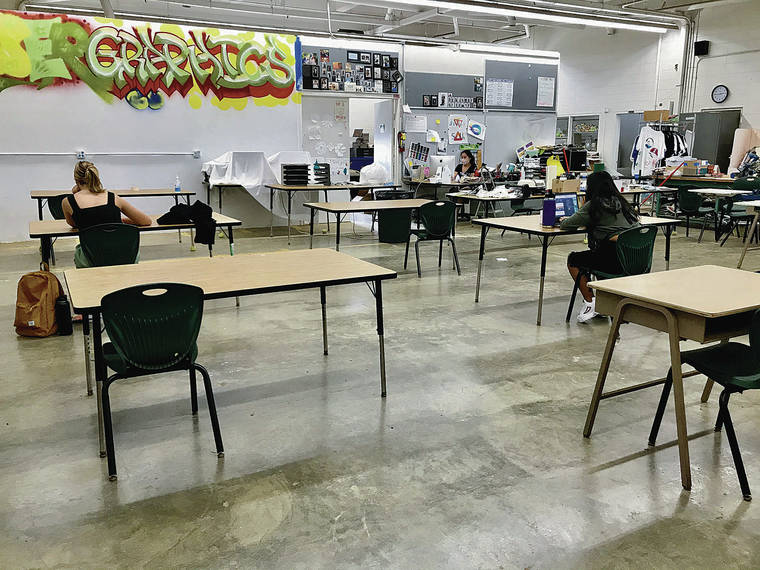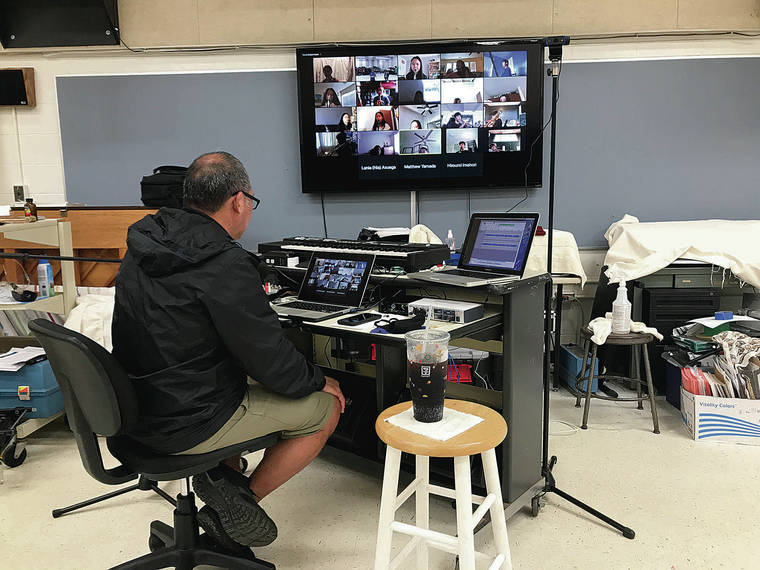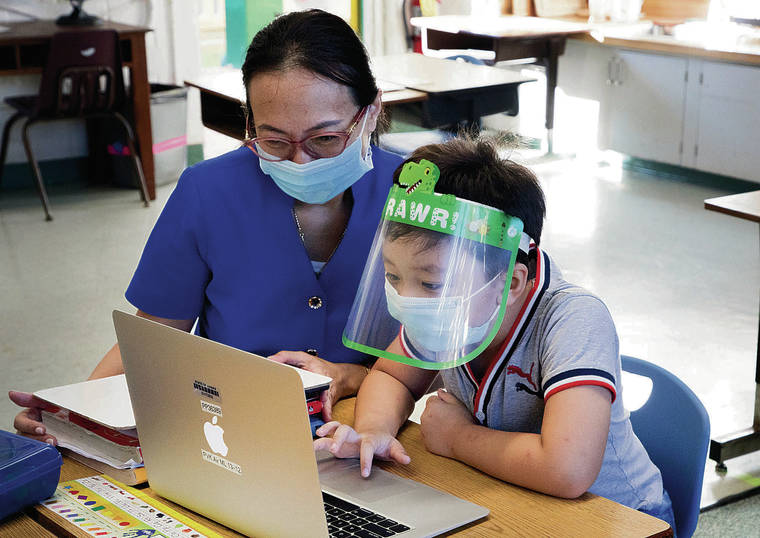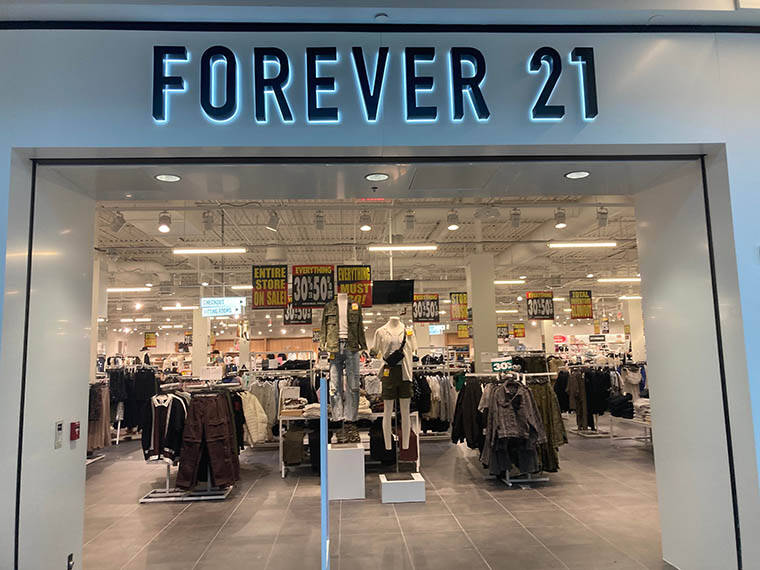More public school students in Hawaii head back to campus

COURTESY JUSTIN MEW / HAWAII DEPARTMENT OF EDUCATION
Students in teacher Maile Tran’s arts and communications class at Kaiser High School in November learned Photoshop synchronously online, while others were physically in school and socially distanced. Below, a Kaiulani Elementary first grader completed an assignment on his first day back at campus in November for in-person learning.

COURTESY HAWAII DEPARTMENT OF EDUCATION
A Kaiulani Elementary first-grader completes an assignment on his first day back to campus for in-person learning in November.

COURTESY JUSTIN MEW / HAWAII DEPARTMENT OF EDUCATION
Band director Michael Bataluna, above, worked with students at Kaiser High School in November as they “play it once more all together but apart.” At left, with his mom by his side, a Kaiulani Elementary first grader gets acquainted with a laptop on his first day back on campus for in-person learning in November.

COURTESY HAWAII DEPARTMENT OF EDUCATION
With his mom by his side, a Kaiulani Elementary first-grader gets acquainted with a laptop on his first day back to campus for in-person learning in November.




Things are almost back to normal in Charisse Kapapa’s fifth grade classroom at Kaiulani Elementary School, where her students report every day for “face-to-face” teaching — albeit wearing masks.
The Kalihi school brought back its kindergartners and first graders full time in November. This month the second and fifth graders began coming daily, while other kids attend on alternate days. Since some families still prefer remote learning, students can socially distance on campus.
“The kids have been a joy,” said Kapapa, whose students returned earlier this month, about the same time that she got her second dose of the coronavirus vaccine. “They’re excited to be back in school, and we’re excited to be teaching them.”
“I can see way more assignments coming in now that they’re in school,” she added.
Public schools are bringing more students back to school this semester, as the Centers for Disease Control and Prevention is calling for a broader reopening of schools Opens in a new tab. The federal agency says evidence shows K-12 schools can be opened safely with proper precautions, and vaccination of staff is not a prerequisite.
Slightly more than half of all public school teachers in Hawaii have received a coronavirus vaccination so far, according to a survey last week by the Hawaii State Teachers Association. Of the 11,088 members who responded, 52% said they had received either one or two doses of the vaccine.
Don't miss out on what's happening!
Stay in touch with breaking news, as it happens, conveniently in your email inbox. It's FREE!
Another 16% have appointments for their first doses. Only 1.6% said they did not want to ever get the vaccination, while 8% opted not to disclose their situation and the remainder were awaiting appointments or considering getting inoculated later.
Roosevelt High School has forged ahead, phasing in the return of all its students this semester. The school has an enrollment of 1,460, with 160 students doing full distance learning this academic year, according to Principal Sean Wong.
The remaining students are split into two teams. The red team attends school on campus on Monday and Wednesday, and gold on Tuesday and Thursday, so roughly 550 students are on campus each day, Wong said. Teachers give their full attention to the kids in their classrooms, while students work independently on the rotating two days that they are home.
“On Friday the teachers wanted to have a day where they can meet synchronously with all their students,” Wong said. “It’s a virtual day. The students don’t come on campus, but they connect with the whole class.”
The new schedule seems to be working. Last week — with all grade levels back on campus — attendance hit 95%, Wong said. Students risk an unexcused absence if they don’t attend on their assigned days.
“Our students have just been really awesome in coming back,” Wong said. “And our teachers have been real troupers. It’s been a total team effort on everyone’s part.”
“We’ve stressed the three main mitigation strategies: wearing masks, social distance and frequent hand-sanitizing and hand-washing,” he added. “We’ve also tried to have the best ventilation possible. We secured some air purifiers for the classrooms.”
In Hawaii Kai, Kaiser High also had hoped to break its student body into just two groups, but ultimately realized it needed to have four groups for adequate spacing in the blended learning rotation it launched Jan. 19, according to Principal Justin Mew.
In addition, about 50 students with greater needs — academic or social — can attend daily.
“Our counselors have identified a bunch of students who are still making good grades but that we need to bring back now because they are isolated or they’re having social- emotional issues or their home situation is such that it’s best to bring them back,” Mew said.
“Even my teachers feel isolated,” he added. “And many are under tremendous stress because they can sense if a student is getting it or not. They are very engrossed with their students and answering emails from parents.”
Students in blended learning take four different classes, on alternating days. But the rotation puts them on campus just one of every nine school days. Wednesdays are set aside for appointments with teachers for individualized help.
Among the students in blended learning, however, just 38%, or 397 students, are actually coming to school on their designated days. The remaining 62%, or 643 students, decided to participate in the same classes remotely.
That’s in addition to the 136 Kaiser students who had already chosen a separate, 100% remote learning program for the entire year.
“The parents are torn because of the concern about COVID spread,” Mew said. “Those opting out (of in- person class) include students we identified with social-emotional learning (needs). The parents don’t feel comfortable with them coming in. It breaks our heart. At the same time, we understand.”
English teacher Sarah Shiroma said she typically can seat 30 students in her classroom, but this year the maximum is 10 due to distancing requirements. So far, just a handful of students have decided to come in person.
Since students are grouped by alphabet, they might not see their friends on the infrequent in-person days.
“The best thing about school is the interaction you get with your peers and your teacher, and that’s missing right now,” Shiroma said. “The initial reason why I think a lot of students opted out was for health and safety reasons, but now I think students are opting out because it doesn’t feel like school.”
“I teach juniors and seniors,” she said. “It’s really sad for my seniors. We’ve had two years of kids now that have missed incredibly important milestones in their high school careers. I totally get why they would want to come back to school and be normal, but there are so many factors at play that can’t allow that right now.”
Statewide, 26% of students have opted for full-time remote learning. The remaining 74% are either back to school full time or have opted for “blended learning.” But even those who chose blended learning may still be studying from home because their schools have not yet opened up except for vulnerable kids.
Some of the big high schools on Oahu remain in distance learning. Kauai, by contrast, had elementary students in blended learning last quarter, and its secondary schools followed suit this quarter.
Kaiulani Elementary found that demand for in- person instruction grew as more families got a chance to see it in action. While 120 students were on full distance learning last semester, the number dropped to 70 this semester, out of a student body of 325 students.
“There’s more lessons learned in a classroom with other students and teachers than just academics,” Principal Jill Texeira said. “Students learn social skills; they learn how to collaborate.”
The school had originally planned for three sections of in-person kindergarten, but opened up a fourth to meet demand in January, she said. And so many first graders chose to return that they now have to rotate days on campus for lack of space.
Her second and fifth grade teachers had small enough class sizes that they asked whether they could bring back all their students this semester — and have done so.
“My teachers are so dedicated and want to do the best for our students,” Texeira said. “It was possible because of our teachers and their kindness and working together, and putting kids first.”
Although the Kalihi school has had kids on campus since special-needs preschoolers came back in October, no cases of COVID-19 have been reported so far.
“I thank God that it hasn’t come on to our campus, and may it continue to be that way,” Texeira said. “We are doing everything we can to keep everyone safe.”




